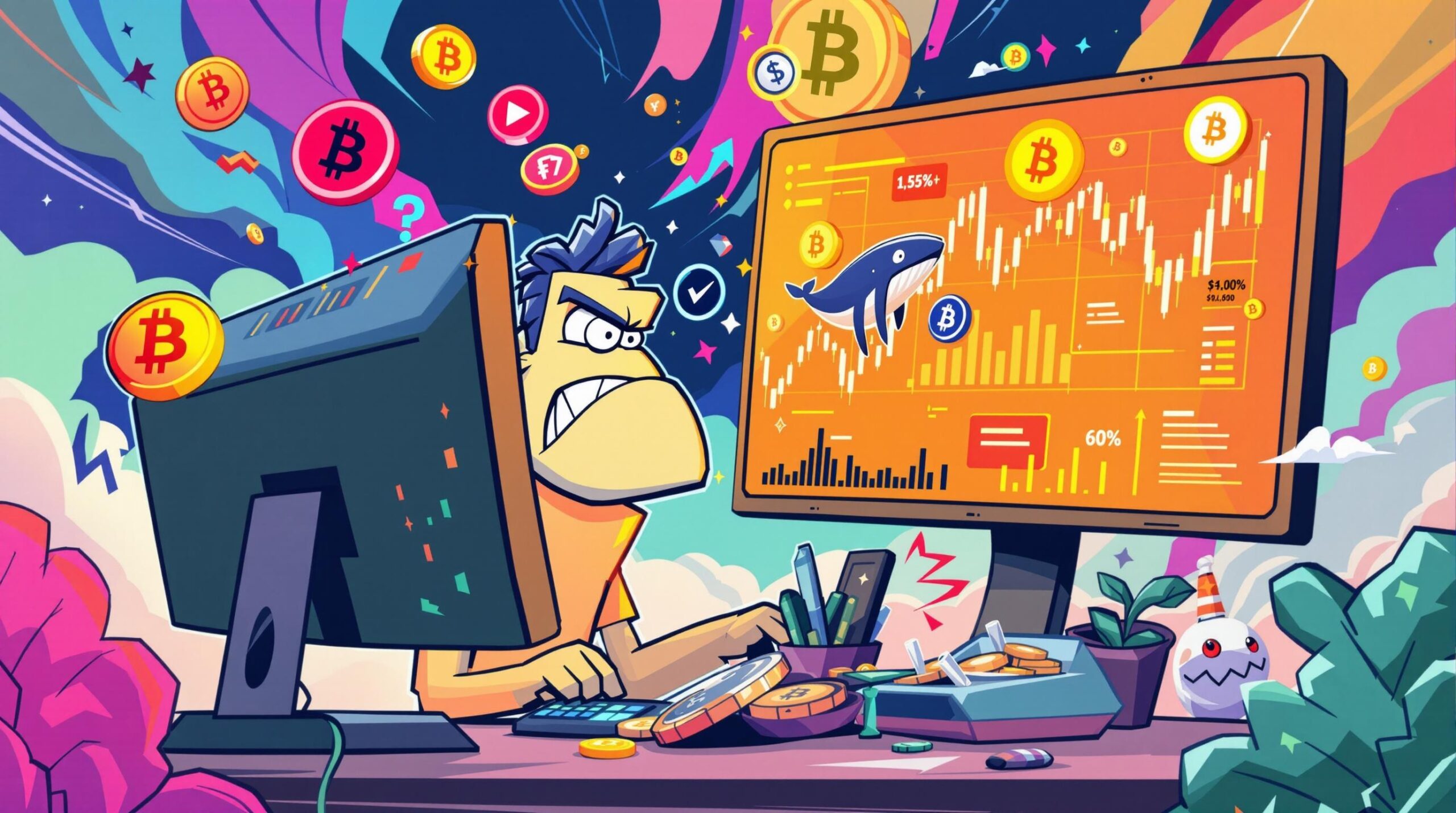BitcoinWorld

Jeffrey Huang’s Audacious Bet: Doubling Down on PUMP Amidst Staggering Losses
In the high-stakes world of cryptocurrency, where fortunes can be made or lost in the blink of an eye, the actions of prominent figures often capture the attention of the wider community. One such figure is Jeffrey Huang, a Taiwanese singer and well-known Bored Ape Yacht Club (BAYC) NFT whale. His recent moves in the volatile meme coin market have sparked considerable discussion, as he continues to increase his long positions in PUMP despite accumulating over $10 million in unrealized losses.
Understanding Jeffrey Huang’s Bold Maneuver
The crypto market is no stranger to bold bets, but the sheer scale of Jeffrey Huang‘s current predicament with PUMP is turning heads. According to on-chain data shared by Lookonchain on X, his losses are not just substantial; they are a stark reminder of the inherent risks in highly speculative assets. His reported unrealized losses are broken down into two significant categories:
- Spot Holdings: A staggering $2.17 million in losses on his direct holdings of PUMP tokens.
- Perpetual Contracts: An even larger sum of $8.14 million on perpetual futures contracts related to PUMP.
For those unfamiliar, perpetual contracts are a type of derivative that allows traders to speculate on the future price of an asset without owning the underlying asset itself. They are highly leveraged, meaning a small price movement can lead to significant gains or losses, amplifying the risk considerably. The fact that a significant portion of Jeffrey Huang‘s losses stems from these leveraged positions underscores the aggressive nature of his trading strategy.
Who is Jeffrey Huang, and Why Does His Bet Matter?
Beyond the raw numbers, it’s important to understand why Jeffrey Huang‘s actions resonate so widely. Known in the crypto space as ‘Machi Big Brother,’ he isn’t just a celebrity; he’s a long-standing and influential figure within the NFT and broader crypto ecosystem. His early adoption and significant holdings of high-value NFTs, particularly within the Bored Ape Yacht Club collection, have given him a ‘whale’ status – a term used for individuals holding substantial amounts of cryptocurrency or digital assets, whose trades can significantly impact market prices and sentiment.
When a whale like Jeffrey Huang makes such a public and seemingly defiant move, it invites speculation and analysis:
- Is it a display of unwavering conviction in PUMP’s future potential?
- Is it a calculated risk, perhaps based on insider information or a unique market perspective?
- Or is it a classic example of the ‘sunk cost fallacy,’ where one continues to invest in a losing position in the hope of recovering previous losses?
His decision to double down, despite the mounting red figures, provides a fascinating case study into the psychology of high-stakes crypto trading.
The Perilous Path of PUMP: A Meme Coin’s Volatility
The asset at the heart of Jeffrey Huang‘s predicament, PUMP, is characteristic of the meme coin phenomenon. These tokens are often created with little to no fundamental utility, deriving their value primarily from community hype, social media trends, and speculative trading. Their prices can skyrocket or plummet with extreme speed, making them incredibly attractive to risk-takers but equally dangerous for those seeking stable investments.
The inherent challenges with meme coins like PUMP include:
- Extreme Volatility: Price swings of 50% or more in a single day are not uncommon.
- Lack of Fundamentals: Unlike established cryptocurrencies with development roadmaps or real-world applications, meme coins often lack intrinsic value.
- Liquidity Issues: While some meme coins gain significant trading volume, many suffer from low liquidity, making large trades difficult without impacting the price.
- Pump-and-Dump Risks: Their community-driven nature makes them susceptible to coordinated pump-and-dump schemes, where prices are artificially inflated before being sold off, leaving late buyers with losses.
Jeffrey Huang‘s continued investment in such an asset highlights the strong conviction some traders hold, even when faced with significant headwinds.
What Can We Learn from Jeffrey Huang’s Trading Saga?
While most individuals won’t be trading with millions of dollars, Jeffrey Huang‘s situation offers valuable lessons for any crypto investor, regardless of portfolio size. It underscores several critical aspects of navigating the unpredictable crypto landscape:
1. The Importance of Risk Management
Even experienced traders and whales can face substantial losses. This scenario emphasizes the paramount importance of strict risk management strategies. This includes setting stop-loss orders, never investing more than you can afford to lose, and diversifying your portfolio to avoid over-exposure to a single, highly volatile asset like PUMP.
2. The Psychology of Trading: Overcoming Biases
The human element in trading is often overlooked. Emotions like fear, greed, and hope can cloud judgment. Doubling down on a losing position, especially when the losses are substantial, can be a symptom of cognitive biases such as the ‘sunk cost fallacy’ or overconfidence. Recognizing these biases is the first step toward making more rational decisions.
3. Due Diligence and Understanding Asset Classes
Before investing, thoroughly research the asset. Understand its utility, its community, its tokenomics, and its inherent risks. Meme coins, while offering explosive potential, come with an equally explosive downside. Differentiating between speculative bets and fundamentally strong projects is crucial.
4. The Impact of Whale Movements
Whales like Jeffrey Huang have the power to influence market sentiment. While his actions might be driven by personal conviction, they can inadvertently encourage others to follow suit, sometimes leading to a cascade of buying or selling pressure. Smaller investors should be cautious about blindly following whale movements without conducting their own research.
Navigating the Future: A Test of Conviction for Jeffrey Huang
As the crypto market continues its dynamic dance, all eyes will remain on Jeffrey Huang and his PUMP positions. His continued doubling down is a testament to either an extraordinary belief in the project’s rebound or a stubborn refusal to accept defeat. This saga serves as a compelling narrative within the broader crypto space, highlighting the exhilarating highs and devastating lows that define this nascent, yet rapidly evolving, financial frontier.
Ultimately, Jeffrey Huang‘s journey with PUMP is a powerful reminder that while crypto offers unprecedented opportunities, it also demands an unparalleled level of caution, research, and emotional discipline. Only time will tell if his audacious bet will pay off or if the unrealized losses will cement into a permanent reality.
Frequently Asked Questions (FAQs)
Q1: What is a crypto ‘whale’?
A crypto ‘whale’ is an individual or entity that holds a very large amount of a particular cryptocurrency or digital asset. Their large holdings mean that their trading actions (buying or selling) can significantly influence market prices and overall sentiment.
Q2: What are ‘unrealized losses’ in crypto trading?
Unrealized losses refer to the theoretical loss on an investment that has not yet been sold. If you buy an asset for $10 and its price drops to $5, you have an unrealized loss of $5. This loss only becomes ‘realized’ (actual) if you sell the asset at the lower price.
Q3: How do perpetual contracts work, and why are they risky?
Perpetual contracts are derivative products that allow traders to speculate on the price of an asset without an expiration date, unlike traditional futures contracts. They are highly risky because they typically involve high leverage, meaning small price movements can lead to large profits or losses, and traders can be liquidated if their margin falls below a certain level.
Q4: What is a ‘meme coin’?
A meme coin is a cryptocurrency that originates from an internet meme or has humorous characteristics. They often lack significant utility or a clear development roadmap, with their value primarily driven by community hype, social media trends, and speculative trading. Examples include Dogecoin and Shiba Inu.
Q5: What is the ‘sunk cost fallacy’ in trading?
The sunk cost fallacy is a cognitive bias where individuals continue to invest time, money, or effort into a losing endeavor because they have already invested so much, rather than cutting their losses. In trading, it can lead to holding onto losing positions in the hope of recovering previous investments, often leading to further losses.
If you found this article insightful, please share it with your network on social media to help others understand the complexities and risks of crypto trading!
To learn more about the latest crypto market trends, explore our article on key developments shaping the future of digital assets.
This post Jeffrey Huang’s Audacious Bet: Doubling Down on PUMP Amidst Staggering Losses first appeared on BitcoinWorld and is written by Editorial Team





